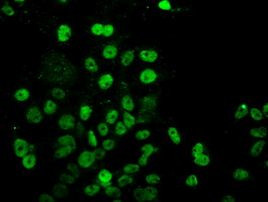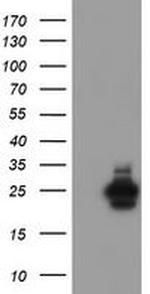Search Thermo Fisher Scientific
产品信息
MA5-26359
种属反应
宿主/亚型
分类
类型
克隆号
抗原
偶联物
形式
浓度
纯化类型
保存液
内含物
保存条件
运输条件
RRID
靶标信息
The ubiquitin (Ub) pathway involves three sequential enzymatic steps that facilitate the conjugation of Ub and Ub-like molecules to specific protein substrates.The first step requires the ATP-dependent activation of the Ub C-terminusand the assembly of multi-Ub chains by the Ub-activating enzyme known as the E1 component. The Ub chain is then conjugated to the Ub-conjugating enzyme (E2) to generate an intermediate Ub-E2 complex. The Ub-ligase (E3) then catalyzes the transfer of Ub from E2 to the appropriate protein substrate. A wide range of enzymes facilitate in the proteolytic Ub pathway including UBE2E3, also designated UBCH9, which catalyzes the covalent attachment of ubiquitin to other proteins and is involved in the regulation of transepithelial sodium transport in renal cells. UBE2E3 may also be involved in cell growth arrest. The UBE2E3 protein shuttles between the cytoplasm and nucleus in a IPO11-dependent manner. It is ubiquitously expressed at low levels and is highly expressed in skeletal muscle.
仅用于科研。不用于诊断过程。未经明确授权不得转售。
篇参考文献 (0)
生物信息学
蛋白别名: E2 ubiquitin-conjugating enzyme E3; UbcH9; Ubiquitin carrier protein E3; ubiquitin conjugating enzyme E2E 3; Ubiquitin-conjugating enzyme E2 E3; Ubiquitin-conjugating enzyme E2-23 kDa; ubiquitin-conjugating enzyme E2E 3 (homologous to yeast UBC4/5); ubiquitin-conjugating enzyme E2E 3 (UBC4/5 homolog, yeast); Ubiquitin-protein ligase E3
基因别名: UBCE4; UBCH9; UbcM2; UBE2E3
UniProt ID: (Human) Q969T4
Entrez Gene ID: (Human) 10477





